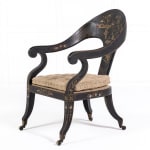A Rare 19th Century English Regency Japanned Klismos Armchair
SOLD
A Fine, Rare English Regency Period Klismos or Spoon Back Armchair with Original Japanned or Lacquered Finish.
Chairs of this form, known as Klismos chairs after the classical Greek originals or often called spoon back chairs in the trade, are sought after as they have a very distinct look about them which makes them perfect feature pieces in a fine interior. Most chairs of this sort are simply painted but this example is particularly interesting in that it features chinoiserie decoration of the sort known at the time as "japanning" a catch-all term to refer to anything that imitated oriental lacquer of any sort, whether Chinese or Japanese. Here the inspiration appears to be Chinese lacquer and the panels of fine painted decoration and floral bouquets are beautifully executed. There are also some traces of neoclassical decoration, in particular in the use of swags of harebells on the front sabre legs. The back splat is ornamented with the largest single panel of decoration, showing a series of figures in a "Chinese" landscape with pagodas, fretwork fences and a bridge.
Chinoiserie furniture first appeared in England in any kind of quantity in th 17th century and from that point onwards it was an enduring trend. By the regency period, the wealthy were able to import wonderful goods from the Orient through the various East India companies and the elite might have rooms of Chinese wallpaper, porcelain, lacquered goods and the like and furniture of this sort was the ideal complement to such interior schemes. Perhaps the most important and famous example of Chinoiserie in this period was the Prince Regent's Brighton Pavilion, a riot of orientalism which was hugely influential and helped to popularise the trend once again.
H 89cm x W 55cm x D 64cm
H 35” x W 21¾” x D 25¼”
Seat Height: 40cm
Seat Depth: 48cm
A Fine, Rare English Regency Period Klismos or Spoon Back Armchair with Original Japanned or Lacquered Finish.
Chairs of this form, known as Klismos chairs after the classical Greek originals or often called spoon back chairs in the trade, are sought after as they have a very distinct look about them which makes them perfect feature pieces in a fine interior. Most chairs of this sort are simply painted but this example is particularly interesting in that it features chinoiserie decoration of the sort known at the time as "japanning" a catch-all term to refer to anything that imitated oriental lacquer of any sort, whether Chinese or Japanese. Here the inspiration appears to be Chinese lacquer and the panels of fine painted decoration and floral bouquets are beautifully executed. There are also some traces of neoclassical decoration, in particular in the use of swags of harebells on the front sabre legs. The back splat is ornamented with the largest single panel of decoration, showing a series of figures in a "Chinese" landscape with pagodas, fretwork fences and a bridge.
Chinoiserie furniture first appeared in England in any kind of quantity in th 17th century and from that point onwards it was an enduring trend. By the regency period, the wealthy were able to import wonderful goods from the Orient through the various East India companies and the elite might have rooms of Chinese wallpaper, porcelain, lacquered goods and the like and furniture of this sort was the ideal complement to such interior schemes. Perhaps the most important and famous example of Chinoiserie in this period was the Prince Regent's Brighton Pavilion, a riot of orientalism which was hugely influential and helped to popularise the trend once again.
H 89cm x W 55cm x D 64cm
H 35” x W 21¾” x D 25¼”
Seat Height: 40cm
Seat Depth: 48cm
#3213
Further images
-
(View a larger image of thumbnail 1
)

-
(View a larger image of thumbnail 2
)

-
(View a larger image of thumbnail 3
)

-
(View a larger image of thumbnail 4
)

-
(View a larger image of thumbnail 5
)

-
(View a larger image of thumbnail 6
)

-
(View a larger image of thumbnail 7
)

-
(View a larger image of thumbnail 8
)

Be in the know...
* denotes required fields
We will process the personal data you have supplied to communicate with you in accordance with our Privacy Policy. You can unsubscribe or change your preferences at any time by clicking the link in our emails.







